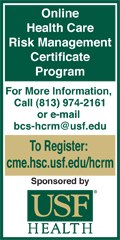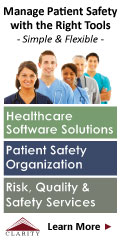 |
 |
 |

January / February 2005

Six Sigma
One Piece of the Patient Safety Puzzle:
Advantages of the Six Sigma Approach

By Carolyn Pexton
Faced with serious cost and quality issues, healthcare providers have increasingly looked at methods like Six Sigma to take their improvement efforts to a higher level. Some hospitals have been on this journey for several years, and are now able to share their experiences, results, and the lessons learned along the way.
Why Six Sigma? A variety of factors have propelled this movement, including the need for a more rigorous approach to ensuring quality — one that extends beyond the quality department, and actually becomes a foundation for creating a culture of excellence throughout the organization.
Background: The Journey Begins
Bringing Six Sigma to healthcare began in the late 1990s. In 1998, Dr. Mark Chassin published an article in The Milbank Quarterly titled "Is Health Care Ready for Six Sigma Quality?" In the article, Dr. Chassin offered both a cogent analysis of the underlying causes for medical errors — primarily centered around underuse, misuse, and overuse — and an argument for adopting methods like Six Sigma as part of an overall framework for change.
In reference to objections from fellow physicians that any efforts to standardize healthcare would amount to cookbook medicine, Dr. Chassin said in this article, "It is impossible to imagine an airline pilot objecting to 'cookbook flying' when asked to use a preflight checklist." He concluded the article by saying, "We can learn a good deal from industries that are working toward the Six Sigma goal. Let's try it in healthcare and see how close we can get."
That same year, the first full-scale Six Sigma initiative in healthcare began at Commonwealth Health Corporation in Kentucky, and other hospitals and health systems were soon to follow. Analyzing industry challenges and potential solutions, organizations like Commonwealth had begun to ask, if not this, what? And if not now, when?
Six Sigma Projects in Healthcare
One critical aspect of Six Sigma is the emphasis on carefully selecting, prioritizing, and scoping improvement opportunities. Not every issue is a suitable candidate for a Six Sigma project. The scoping process helps to ensure projects are aligned with organizational objectives, present a clear opportunity for improvement, and will yield measurable results.
In selecting and scoping projects, healthcare organizations should ask the following questions:
- Is the project aligned with strategic priorities?
- What will be considered in or out of scope (i.e., inpatient vs. outpatient)?
- Will the project team have access to valid data?
- What are the potential benefits (qualitative and quantitative) for the organization?
- How long will it take to complete the project?
- Is the sponsor passionate about this issue?
- Does the problem require in-depth analysis (i.e., no obvious solution)?
- Are there opportunities for translation or "spread" of project results?
- Is there a significant gap between the current state and desired performance (including meeting regulatory specifications)?
- Is there a sense of urgency to address the problem?
- Will the organization commit appropriate resources toward the project?
Supporting Patient Safety:
The Business Case
A recent HealthGrades report nearly doubled earlier estimates of preventable hospital deaths. While exact numbers may be a matter of dispute, consensus does seems to exist around a few points: Too many medical errors occur, most are the result of systemic rather than people issues, and mistakes in healthcare are costly, in terms of human suffering and in the financial burden on the system.
Healthcare leaders who have adopted Six Sigma acknowledge the cost of poor quality and the undeniable connection between margin and mission. While the link may be more obvious between patient safety and true clinical projects, such as reducing hospital acquired infections or preventing medication errors, benefits can also be drawn from operational projects that seek to remove inefficiency from the system and improve the bottom line.
For example, a project focused on streamlining workflow in the perioperative environment may allow nurses to spend more time actually caring for patients and less time chasing supplies or producing redundant documentation. Projects delivering significant cost savings or added revenue to the organization may free capital that can be used to hire additional nurses, acquire new lifesaving technologies, invest in CPOE, and so on. In short, quality and cost management are not mutually exclusive concerns, and a strong business case can be made for implementing Six Sigma and change management techniques.
Perhaps most importantly, though, beyond the results of any particular project, is the culture change that can take place when Six Sigma is implemented appropriately. Giving people a common set of tools and skills and empowering them to use a team-based approach to solve problems helps to lay a strong foundation for sustainable change.
Summary
A number of fairly consistent factors have emerged as key to successfully implementing Six Sigma or other major change initiatives in healthcare. Some of these lessons have been learned the hard way, and by sharing the insights and experiences of healthcare providers who have blazed the trail, perhaps others will be able to avoid common pitfalls.
It is also important to remember that this is a journey — not a destination. In healthcare organizations where Six Sigma has become ingrained as part of the overall business strategy, the leadership has recognized that it isn't really about training or even about the tools themselves. Six Sigma is about looking at things from a new, evidence-based angle and using a consistent approach to managing and leading change. It's also about making an investment in people — equipping staff with solid skills and empowering them to solve the problems they face in their daily work.
In short, Six Sigma is a great method for reducing process variation and defects, but it is only one component in providing an overall framework for organizational transformation. Six Sigma is not a "magic bullet," and transforming healthcare will also likely require changes in technology, leadership development, legislation/regulation, transparency, and culture.
Carolyn Pexton has 18 years experience in communications and healthcare and is the director of communications for Performance Solutions at GE Healthcare. She is a certified Green Belt and can be contacted at carolyn.pexton@med.ge.com.
Bibliography
Breyfogle, F.W., III, Cupello, J.M., & Meadows, B. (2003). Managing Six Sigma: A practical guide to understanding, assessing, and implementing the strategy that yields bottom-line success. New York: John Wiley & Sons.
Eckes, G. (2001). The Six Sigma revolution: How General Electric and others turned process into profits. New York: John Wiley & Sons.
Eckes, G. (2003). Six Sigma for everyone. New York: John Wiley & Sons.
Foster, S. T. (2004). Managing quality: An integrative approach. Upper Saddle River, New Jersey: Pearson Prentice Hall.
International Society of Six Sigma Professionals. www.isssp.com
iSixSigma healthcare portal. www.healthcare.isixsigma.com
Kerzner, H. (2003). Project management: a systems approach to planning, scheduling, and controlling. Upper Saddle River, New Jersey: Pearson Prentice Hall.
Kinicki, A, & Kreitner, R. (2003). Organizational behavior: key concepts, skills & best practices. New York: McGraw Hill.
Pande, P.S., Neuman, R.P., & Cavanagh, R.R. (2000). The Six Sigma way: How GE, Motorola and other top companies are honing their performance. New York: McGraw Hill.
- Proceedings from the Quality Colloquium at Harvard University:


|
 |
 |
 |























|
 |



